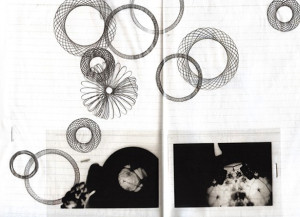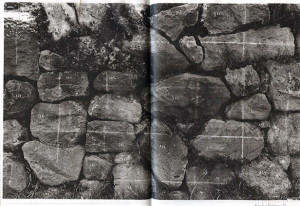Patrícia Araújo sobre Luciana Mendonça
projeto Strange Fruit – atividade 2 – 2012, São Paulo
As pedras e os caminhos
E em nossa breve conversa ela me disse “Por onde ando, durante minhas viagens, recolho algumas pedras que aparecem pelo meu caminho. Coleciono pedras”. Foi com a imagem dessa frase que fui embora. Mas Pedras? Porque será? Talvez uma simbologia para os problemas que ela passou na vida ou apenas por uma decisão de colecionar as pequenas rochas?
A figura da pedra me impressionou bastante, tanto pelo caráter do tempo que estas guardam consigo quanto pela sua imobilidade e imutabilidade – duas caracterísiticas que habitualmente costumamos evitar. Tudo parecia incongrunete pra mim. Ainda não compreendia as pedras no caminho. Podia ver um amontoado delas na minha frente tentando me dizer algo que eu ainda não conseguia ver. Pra quê guardar esse tempo imóvel e encapsulado? Uma coleção de tempos em fragmento? Mas o que são as memórias senão trechos reiventados dos acontecimentos de nossas vidas, não é mesmo?
Tudo ficou mais claro ao ter em minhas mãos seu caderno/diário e algumas confisões guardadas ali. Consegui entrar nas pedras e no que elas tentavam me dizer. Foi bom, me encantei.
Colecionar pedras é se prevenir do esquecimento (sabe-se de seu poder de rocha, que nunca quebra). É lembrar dos caminhos que passamos, da sensação do vento no rosto no final daquela tarde, ou daquele sol forte que mal nos deixava abrir os olhos. É lembrar do colo do avô herói, da viagem feita de carro, das fotos coladas em papel cartão, dos silêncios compartilhados e das perdas inevitáveis.
Cada pedra guarda ali a densidade de uma lembrança, a imobilidade humana diante do tempo, o desejo forte de nunca esquecer e a ilusão de sempre poder voltar.
“No seu discurso o artista da memória precisa apenas repassar em pensamento a sequência de lugares, e com isso pode invocar em série as imagens da memória. Portanteo, é sempre uma paisagem da memória na qual age essa arte, e, nessa paisagem, tudo o que deve ser confiavelmente lembrado tem seu lugar determinado. Só o esquecimento não tem lugar” (WEINRICH: 31)
The stones and the paths
During our short conversation she said to me “By the paths I walk, on my traveling, I pick some stones that appear in my way. I’m used to collect stones”. It was with the image of this phrase that I went away. But stones? Why? Maybe a kind of symbolism for the problems that she passed through in her life or just for a decision to collect little rocks?
The stone’s image really impressed me, as much by the mark of the time that it embodies as by its immobility and immutability – two attributes that we usually tend to avoid. Everything seemed too strange for me. I still didn’t understand the stones on the way. I could see a lot of them in front of me trying to say something that I couldn’t understand. But why keep this static and encapsulated “time”? A collection of fragmented “time”? But what is the memory but the re-invented chapters of our life events, isn’t it?
Everything became clearer when I got her diary in my hands and had access to some confessions kept there. I was able to enter in the stones and in what they were trying to tell me. It was nice, it enchanted me.
To collect stones is a way to avoid the oblivion (the rocks have a well known power, they never break). It’s about remembering the paths we pass, the sensation of the wind against the face on that sunset, or the strong sun that didn’t allow us to open our eyes. It’s remembering the hero grandpa, the trip made by car, the pictures glued on card paper, the silences shared and the inevitable losses.
Each stone keeps the density of a memory, the human immobility before the time, the strong desire of never forgetting and the illusion of always be able to go back.
“When he makes his speech the memory artist has thus only to stroll mentally through the places in order to call up the memory images in sequence. Hence this art is always practiced in a memory-space in which everything that must be remembered has its own specific place. Only forgetting has no place there.” (WEINRICH: 31)


